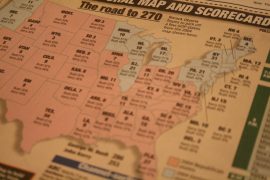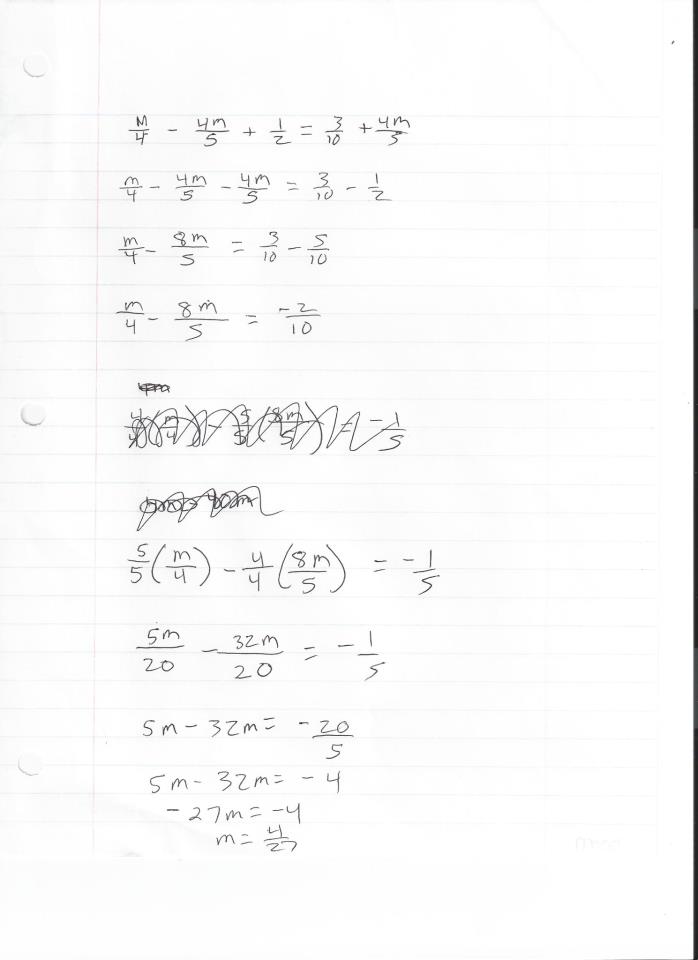This post makes me scared. Not because the math is challenging or because I’m worried about the election. I’m afraid of looking partisan or being accused of ideology. (It’s happened before!) But I can’t avoid election math any longer, so I’ve decided to take the plunge — today and Monday — into these shark-infested waters, trusting that my readers (and new guests) will put away their partisan differences if only for a few hours. Do for the sake of the math.
There’s no denying the math that goes on in elections. There are polls, ad buys, the number of minutes each candidate has spoken during debates — and yes, the electoral college. Whatever you may think of our dear map, it is how elections are decided in this country — for the most part.
There’s no reason to expect a repeat of Election Day (and the weeks following) 2000 this year. So I thought it would be a good idea to review the electoral map — from a mathematical perspective — so that we can better understand its power. First some history.
During the Constitutional Convention in 1787, the founding fathers quickly rejected a number of ways to select the country’s president: having Congress choose the president, having state legislatures choose and direct popular vote. The first two ideas were tossed based on fears of an imbalance of power — giving Congress or the states too much control. They also worried that a direct popular vote would be negatively influenced by the lack of consistent communication. In other words, without information about out-of-state candidates, voters would simply choose the candidate from their own states. And then there was the very real fear that a candidate without a sufficient majority would not be able to govern the entire nation.
So, these fine men drew up a fourth option: a College of Electors. The first design, which is outlined in Article II of the U.S. Constitution, was pitched after four Presidential elections, after political parties emerged. Much of the original system remained, but the 12th Amendment to the Constitution instituted a few changes to reflect the country’s new party system. Here what the electoral college looks like today:
- The Electoral College consists of 538 electors.
- Each state is allotted the same number of electors as it has Congress members (Senators and Representatives)
- Therefore, representation in the Electoral College is dependent on each state’s population. More populous states have more electoral votes; less populous states have fewer electoral votes.
- The 23rd Amendment to the Constitution gives the District of Columbia 3 electoral votes, event though it is not a state.
- Each state has its own laws governing how electors are selected. Generally, electors are selected by the political parties themselves.
- Most states have a “winner takes all” system, which means that the candidate with the majority of the direct popular votes in the state gets all of the electoral votes.
- However, Maine and Nebraska have a proportional system, which means the electoral votes can be divided between candidates.
Whew!
Some basic calculations allow the media and election officials and the candidates themselves to make really good predictions on election night in most situations. But the electors don’t officially cast their votes until the first Monday after the second Wednesday in December. Then, on January 6 of the following calendar year in a joint session of Congress, the electoral votes are counted, and the President and Vice-President are declared. (Got all that?) Almost always, though, the losing candidate concedes the election on election night or the next day, making the electoral vote and counting a mere formality.
The thing that makes this complex is that each state has a different number of electoral votes. In order to win the presidential election, a candidate must secure at least 270 electoral votes. And that’s why you’re probably seeing a red and blue (and purple?) map in your newspaper, on television and online.
In my state, there is no question which candidate will take all of the electoral votes. Maryland has been staunchly Democratic for several decades. And there’s no mystery about Texas, which is about as red as a state can get. But if it were a contest between Maryland’s and Texas’ electoral votes, Governor Romney would win. That’s because Texas has 38 electoral votes, while Maryland has 10.
Right now, there are lots and lots of predictions out there concerning how the electoral college will vote. (Personally, I think Nate Silver0 of the New York Times is the most reliable source. Dude has a killer math brain, correctly predicting the electoral college outcomes in 49 of the 50 states in the 2008 election. In that same election, he correctly predicted all of the 35 Senate races.) But there’s little doubt about many of the states. A few swing states will certainly claim this election: Colorado, Florida, Iowa, New Hampshire, Ohio, Virginia and Wisconsin. Mathematically speaking, we’re talking about 89 votes:
- Colorado: 9
- Florida: 29
- Iowa: 6
- New Hampshire: 4
- Ohio: 18
- Virginia: 13
- Wisconsin: 10
Now out of those, which states would you guess the candidates really want to win? Yep, the ones with the highest number of electoral votes. So to them, the most important states in these last days of the campaign are Florida, Ohio and Virginia. (Where do you draw the line? I chose more than 10 electoral votes.)
If you live in one of these three states, you are acutely aware of this fact. Unless you don’t have a television set or listen to the radio or have a (really) unlisted phone number.
So what does this mean? Right now, it means that President Obama is likely to win the election. There are scenarios that show the opposite outcome — and there are even a few that produce a tie. However, most political analysis says that it’s Obama’s to lose at this point. This is despite the fact that most polls show the popular vote at a statistical dead heat (in other words, any lead by either candidate is well within the margins of error).
Because our founding fathers made a decision that we wouldn’t elect our presidents with a direct popular vote. What matters in these last days are the popular votes in the swing states — most importantly Florida, Ohio and Virginia — though there are scenarios that give Mitt Romney the edge without winning all of the swing states.
If you are a complete geek about election numbers, do visit Silver’s FiveThirtyEight blog at the New York Times. His math is good, regardless of what some conservative pundits have claimed in recent weeks.
EDITOR’S UPDATE: Sam Wang of the Princeton Election Consortium also has great analysis. Hurricane Sandy has messed with his servers, so the site looks pretty rudimentary, but he is updating his site regularly. It’s pretty cool to compare Silver’s and Wang’s conclusions — especially on a day-by-day basis.
I also highly recommend a really slick interactive tool put out by the New York Times. It graphically illustrates ways in which the electoral votes could swing the election in either way, based solely on the math. Unlike Silver’s blog, this section does not offer a prediction of who will will win, but describes the various scenarios for each candidate.
Whatever you think of the candidates and the issues, vote. No matter what, vote. Our votes — even outside swing states — matter. It’s our responsibility as U.S. citizens to declare our preferences. And in my mind, if you don’t vote, you can’t complain.
Coming on Monday… a look at the polls themselves. What makes a good poll? How should we average folks interpret polls? Can they really tell us what’s going on?
What are your thoughts on the math of the electoral college? (I get it. These discussions can get heated. Please be respectful in your comments. I will not approve or will delete any comments that I deem outside the bounds of civility. Thank you for playing nice.)




















